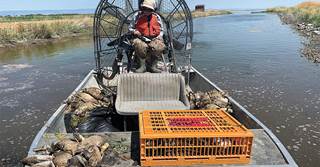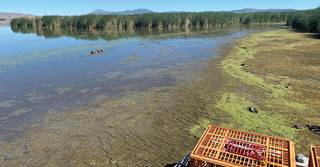Riches to Rags
The decline of the Klamath Basin refuges is a national tragedy, but efforts are under way to restore their value to waterfowl
The decline of the Klamath Basin refuges is a national tragedy, but efforts are under way to restore their value to waterfowl
By Mark Petrie, PhD, Amelia Raquel, and Chris Colson
Along the Oregon and California border lie the Tule Lake and Lower Klamath National Wildlife Refuges. In the fall of 1958, over 5 million waterfowl were counted on these two refuges. A year earlier, 3 million northern pintails were counted on Tule Lake alone, roughly equivalent to the entire continental population of the birds today. From the 1950s through the 1970s these refuges were among the most important waterfowl habitats on earth. They were the gateway to the Central Valley of California, where 60 percent of all waterfowl in the Pacific Flyway wintered.
In August 2020, Tule Lake refuge was the site of an avian botulism outbreak that killed an estimated 50,000 ducks. It was the latest blow for a refuge that now supports waterfowl in the tens of thousands rather than the millions. Although Lower Klamath refuge has fared better over the years, it too is facing hard times. Not long ago, Lower Klamath consisted of 25,000 acres of well-managed wetlands that provided crucial staging habitat for waterfowl and other migratory birds. Now refuge personnel struggle to flood a mere five or six thousand acres. How did two of the most important waterfowl refuges in the United States reach such a sad state?
The decline of the Tule Lake and Lower Klamath refuges was a hundred years in the making. There are no villains here; rather it is simply a tale of too little water to go around on an arid landscape. The road began in 1902, when Congress passed the Reclamation Act. The act provided federal funding for irrigation projects throughout the West. Three years later the Klamath Irrigation Project, or Klamath Project, was born. The project aimed to drain the marshes and lakes of the Upper Klamath Basin, convert them to farmland, and supply them with water. Today, the Klamath Project irrigates over 240,000 acres in Oregon and California.

Siltation, drought, and high botulism outbreak this past summer on Tule Lake National Wildlife Refuge, killing an estimated 50,000 ducks.
Photo John Vradenburg, USFWS
Prior to irrigation, the Upper Klamath Basin contained 350,000 acres of wetlands, most of which were associated with three lakes: Upper Klamath Lake, Lower Klamath Lake, and Tule Lake. In 1908, President Theodore Roosevelt established the Lower Klamath National Wildlife Refuge as the nation's first waterfowl refuge. Tule Lake refuge followed in 1928. Upper Klamath Lake was left as a reservoir to serve as the main source of irrigation water for agriculture in the basin.
By the mid-1970s, the two refuges were heading in opposite directions. Tule Lake refuge consists of two "sumps" surrounded by cropland farmed under contract. Most of these crops are small grains, and farmers leave a portion of their crops for waterfowl. Sump 1A is about 11,000 acres, while Sump 1B is roughly 3,500 acres. Both sumps capture return-flow irrigation water, and they can also function as highly productive wetlands when given the chance. In 1964 Congress formally dedicated both refuges to waterfowl management. Congress also stipulated that the Tule Lake sumps were not to be reduced in size given their importance to waterfowl. However, large wetlands like the sumps need to experience periodic drawdowns to remain productive. In fact, it's best if these wetlands go completely dry in some years. As the quality of the sumps declined, so too did Tule Lake's waterfowl numbers. Lower Klamath refuge fared much better. Managers created a diverse mixture of highly productive wetlands and flooded agricultural habitats, and waterfowl numbers remained strong through the early 2000s.
Adding to an already complex situation, Upper Klamath Lake is home to two species of sucker fish that were listed under the Endangered Species Act (ESA) in 1988. The lake is also the headwaters of the Klamath River, which supports seasonal runs of coho and Chinook salmon. In 1997, these coho salmon were also listed under the ESA, and in 2001 federal agencies concluded that irrigation allocations from the Klamath Project were harming both endangered suckers and coho. The impact was twofold. First, a minimum lake level was established to support the endangered sucker fish. Second, more water would be sent downstream for coho salmon in the Klamath River. As a result, the needs of these endangered fish species took legal precedence over irrigation and refuge habitats.
The winter of 2001 was dry, and water levels in Upper Klamath Lake were already low. That spring no water was allocated for irrigation or for the refuges, and protests in the agricultural community made national news. In following years, water allocated for irrigation and the refuges ebbed and flowed with lake levels. However, in 2020 federal agencies issued a new "biological opinion" that governs water management of Upper Klamath Lake according to the requirements of the ESA. Although Lower Klamath refuge needs about 95,000 acre-feet of water per year to be properly managed, the biological opinion restricted the refuge to a mere 11,000 acre-feet when lake levels permit. To make matters worse, water can only be delivered to the refuge in the middle of winter, providing little or no fall habitat for waterfowl. Farmers were not spared either, as less than half of their irrigation needs were met in 2020 because of low lake levels.
Until recently, Tule Lake refuge had mostly escaped the impact of water shortages as irrigation return flows had provided the sumps with enough water. In 2020, however, less water returned to the sumps. Much of Sump 1A, the site of this summer's botulism outbreak, has silted in. Less water and more silt turned much of the sump into a mudflat. That, along with a heat wave, provided ideal conditions for the disastrous botulism outbreak.

Photo John Vradenburg, USFWS
What can be done? Restoring the productivity of the Tule Lake sumps would be a huge leap forward. In 2002, Sump 1B was drained and allowed to dry out. The vegetation response was phenomenal, and duck use of the area was the highest in decades. Sump 1B was drained again this spring with similar results. The much larger Sump 1A poses a more difficult challenge. Although the infrastructure needed to properly drain the sump is not yet in place, DU staff are working with the refuge, the Tulelake Irrigation District (TID), the Klamath Water Users Association, and the Bureau of Reclamation (BOR) to make that a reality. This same infrastructure would reduce the likelihood of future botulism outbreaks. Rehabilitating Sump 1A would also allow farmers to periodically cultivate some of its rich soils and do the necessary work of setting back wetland plant succession.
The challenges facing Lower Klamath refuge may be even greater. DU is working with a variety of partners including the refuge, TID, Klamath Drainage District, and BOR to find alternative sources of water and to improve the efficiency of the refuge's water-delivery system. The farming community is also helping by flooding agricultural lands to offset the loss of refuge habitats. Nevertheless, a lasting solution will likely require one of two things. First, future biological opinions could finally recognize the importance of the refuge and allocate the water it needs, but that road is likely to be very long, uncertain, and heavily litigated. Currently, DU is helping to lead a group of Klamath Basin stakeholders who wish to find collaborative, community-based solutions to the region's water challenges. DU is serving as a strong advocate for the refuges within this group. Going forward, restoring the waterfowl benefits once provided by these important public lands will remain a top priority for DU in the West.
Dr. Mark Petrie is director of conservation planning and Amelia Raquel and Chris Colson are biologists in DU's Western Region.
Ducks Unlimited uses cookies to enhance your browsing experience, optimize site functionality, analyze traffic, and deliver personalized advertising through third parties. By continuing to use this site, you agree to our use of cookies. View Privacy Policy